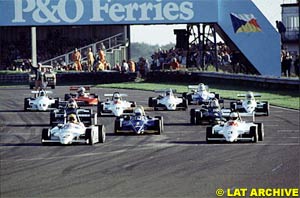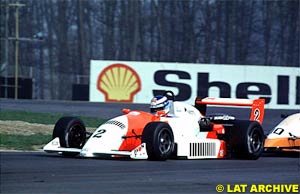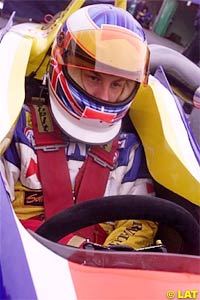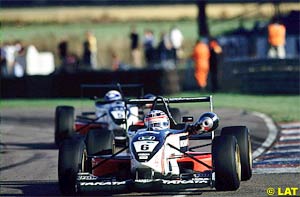
Contributing Writer
Mika Hakkinen, Ayrton Senna, Nelson Piquet, Emerson Fittipaldi, Jackie Stewart. Each one a double or triple Formula One World Champion. All made their names by winning the British Formula Three championship. Drivers who tried and failed to win the British F3 title include James Hunt, Nigel Mansell and Damon Hill. Luke Martin tells the story of the world's most prestigious F3 series and analyses why it is the best championship
During the 1960s, Frank Williams earned his reputation for hard work and entrepreneurship when he sold cars to pay for his passion of driving in F3. He finally moved into team management when he prepared an F3 car for Piers Courage in 1967.
In 1969, a long tradition of Brazilian drivers racing in British F3 was begun when Emerson Fittipaldi won the title in a Lotus. Other emerging talent that year included James Hunt, whose driving was rather less refined than when he won the F1 World Championship.
In the 1970s, the engine rules changed. From 1970 to '73, 1600cc engines were used. In 1974, F3 switched to the 2000cc engine capacity which remains to this day. Tom Walkinshaw raced in British F3 in the '70s before eventually finding success in touring cars.
In 1978, Nelson Piquet continued Britain's love affair with Brazilians when he won the championship. Another driver to turn heads that year was Nigel Mansell. He arrived at Silverstone having driven just a handful of laps in his F3 car, then stunned observers by taking pole position on a wet track.
1983 is still remembered as a classic season for British F3, with Ayrton Senna winning a titanic battle for the title with Martin Brundle in the very last race. In '87, Johnny Herbert won the championship for Eddie Jordan's racing team. The following year, Damon Hill had his best season in F3, finishing third in the series, while Eddie Irvine could only manage fifth. In 1989 the young Mika Hakkinen had a disappointing year, finishing a lowly seventh. The runner-up in that year's championship was Allan McNish.
The 1990s saw many current F1 drivers competing in the British F3 series. In 1990 Mika Hakkinen won the title, beating his countryman Mika Salo. In '91, Rubens Barrichello took pole position for his first British F3 race. As the lights turned green, the Brazilian stalled and was rammed from behind by another driver. He recovered from this to beat David Coulthard to the championship. Pedro de la Rosa competed in the series in '93 and '94, and Juan Pablo Montoya took two wins in the '96 season. Enrique Bernoldi in '98 and Luciano Burti in '99 were both runners-up to the title, with Alex Yoong also appearing in these two years. For Jenson Button, third place in the '99 championship was enough to earn him an F1 call-up with Williams.
In 2001, Takuma Sato became the first Japanese driver to win a major national championship outside Japan when he tied up the British F3 title with four races to spare. The British F3 championship's links with F1 have persisted from its beginning to the present day, with no sign of weakening.
First Among Equals - Why is British F3 the Best?
There are several national F3 championships run to the current FIA regulations, notably the British, German, French and Italian series, all of which have produced current F1 drivers. All of these use cars with identical performance, but the British F3 series is generally perceived to be the most desirable place for a young driver to learn his trade. This begs the question, "Why is British F3 the best?"
First, a description of the cars and the championship. Formula Three technical regulations are strictly defined by the FIA, and are designed to ensure virtually equal performance from all cars. This is so that F3 can be regarded as a test of driver skill rather than of manufacturer ingenuity.
The engines used in F3 are also strictly regulated to give equal performance. All engines must have a maximum capacity of 2 litres, and be derived from a production engine of which more than 2500 have been sold. Inlet air restrictors limit the power to a maximum of around 212bhp. The main engine manufacturers in British F3 are Mugen-Honda, Renault-Sodemo and Speiss-Opel. 5-speed manual gearboxes are mandatory. The performance of F3 cars is impressive, with a top speed of around 160mph (255km/h), and the cars can reach 60mph (100km/h) from a standing start in a fraction over 3 seconds.
The British F3 Championship consists of two categories: Championship class and Scholarship class. In the former, drivers use cars of up-to-date specification to battle for the title of British F3 Champion. In the Scholarship class, teams must use two-year-old chassis, the Dallara F398 being de rigeur in 2001. Scholarship class is designed as a training ground for young drivers, and the winner of the class is presented with £125,000 (US$180,000) from the British Racing Drivers Club. The money must be used to further the young driver's racing career.
At each race meeting there are two races, each of approximately 30 miles (approx. 50km). Both classes of car compete in both races, except at circuits with a limited grid capacity, where each class has its own pair of races. In the 2001 season there were a total of twenty-six races, on eleven different circuits.
While the British F3 championship is undoubtedly a closely fought and exciting race series, with no fewer than eight race winners in the 2001 season, its prestige largely comes from its close association with F1. Not only is Britain home to seven F1 teams (and also home to part of the Minardi team), but more current F1 drivers have raced in British F3 than in any other national F3 championship. Of the twenty-two current Grand Prix drivers, all but three have F3 experience (the exceptions being Fernando Alonso, Tomas Enge and Kimi Raikkonen). Of the remaining nineteen drivers, nine have raced in the British F3 championship, six in the German, and two each in the French and Italian series. This statistic makes Britain an attractive place to race.
Another important consideration is that British F3 is very popular among the country's racing fans. This makes the series valuable for television, which in turn makes it valuable for sponsors. Drivers therefore gain experience in talking to corporate sponsors, as well as participating in TV interviews and meeting the fans. It is also the first time in a driver's career that large crowds will have come specifically to watch his race, as fans are keen to watch the future stars of F1. This only adds to the pressure, and a driver who can withstand it and still perform to the best of his abilities is well equipped for an F1 career. The media coverage of British F3 also gives drivers hope of being noticed by F1 teams. The high profile of the series comes at a price. If a driver is not perceived to show promise, sponsors will not keep paying for his race seat. For every young driver in F3, there are many more that are desperate for the opportunity.
In the 37 years since Jackie Stewart won the British F3 Championship, the strength of the series has become almost a self-fulfilling prophecy. The presence of top drivers who become stars of F1 adds to the prestige of the championship, and a prestigious championship will inevitably attract top drivers, and so the cycle continues. This is perhaps the most convincing reason why the British F3 Championship is often referred to as the best national F3 series in the world, and a valuable step along the road to F1.
British F3 is constantly evolving, with recent changes being the creation of the Scholarship class and the move to two races per meeting. For as long as the organisers remain innovative, and the series continues to produce drivers as conspicuously talented as current champion Takuma Sato, the future of the British F3 Championship will remain secure.
The history of F3 in Britain begins in 1947 with the advent of 500cc racing. During the late 1940s and early '50s, drivers including the young Bernie Ecclestone had their first experience of motor racing in the tiny 500cc machines. In 1951, the British Formula Three series was created, using 500cc cars. The first British F3 champion was Eric Brandon, driving a Cooper. During the 1950s, young drivers continued to learn their trade in F3, one of these being Ken Tyrrell, better known for his team management skills.
 The modern era of F3 began in 1964, with the new FIA regulations stipulating 1000cc engines. (At that time F1 was run for 1500cc cars.) The first champion was a Scotsman who had previously impressed in club racing: Jackie Stewart. He utterly dominated the 1964 championship, driving a Cooper prepared by Ken Tyrrell and forging a legendary relationship with the team boss. Of thirteen outings, Stewart won eleven times, along with a second place and a retirement. At the same time, he was competing in European F2. Little wonder that he was snapped up by BRM for their F1 team the next year.
The modern era of F3 began in 1964, with the new FIA regulations stipulating 1000cc engines. (At that time F1 was run for 1500cc cars.) The first champion was a Scotsman who had previously impressed in club racing: Jackie Stewart. He utterly dominated the 1964 championship, driving a Cooper prepared by Ken Tyrrell and forging a legendary relationship with the team boss. Of thirteen outings, Stewart won eleven times, along with a second place and a retirement. At the same time, he was competing in European F2. Little wonder that he was snapped up by BRM for their F1 team the next year.
 Yet another Brazilian won the title in 2000: Antonio Pizzonia, who grew up in the Amazon jungle and is now a star of F3000. Another graduate of that year's British F3 series was Narain Karthikeyan, the first driver from India to drive an F1 car.
Yet another Brazilian won the title in 2000: Antonio Pizzonia, who grew up in the Amazon jungle and is now a star of F3000. Another graduate of that year's British F3 series was Narain Karthikeyan, the first driver from India to drive an F1 car.
 F3 cars look superficially like small F1 cars, and like the top category they are built of carbon fibre and Kevlar, with adjustable front and rear wings to provide aerodynamic downforce. The FIA does not specify a chassis manufacturer, but all British F3 teams currently use Dallara cars, the latest model being the Dallara F301. The maximum weight is 540kg including driver. The lightweight chassis, slick tyres and wings allow the cars to produce cornering forces of just over 2g, with a maximum braking force of around 2.5g.
F3 cars look superficially like small F1 cars, and like the top category they are built of carbon fibre and Kevlar, with adjustable front and rear wings to provide aerodynamic downforce. The FIA does not specify a chassis manufacturer, but all British F3 teams currently use Dallara cars, the latest model being the Dallara F301. The maximum weight is 540kg including driver. The lightweight chassis, slick tyres and wings allow the cars to produce cornering forces of just over 2g, with a maximum braking force of around 2.5g.
 There is also the fact that the lingua franca of F1 is English, and the ability to talk to the media, sponsors, and race engineers in English will be developed during a season of British F3. This is another attraction to young drivers from across the world, as can be seen by the mix of nationalities to be found in the British F3 championship. Around half of the drivers in the 2001 season were British, the rest travelled from Germany, Italy, France, Holland, Ireland, Japan, the USA, Australia, India and Brazil. (With Fittipaldi, Piquet and Senna all having won the title, British F3 is now virtually compulsory for young Brazilians hoping to reach F1.)
There is also the fact that the lingua franca of F1 is English, and the ability to talk to the media, sponsors, and race engineers in English will be developed during a season of British F3. This is another attraction to young drivers from across the world, as can be seen by the mix of nationalities to be found in the British F3 championship. Around half of the drivers in the 2001 season were British, the rest travelled from Germany, Italy, France, Holland, Ireland, Japan, the USA, Australia, India and Brazil. (With Fittipaldi, Piquet and Senna all having won the title, British F3 is now virtually compulsory for young Brazilians hoping to reach F1.)
Please Contact Us for permission to republish this or any other material from Atlas F1.
|
Volume 7, Issue 48
Articles
That was Then, This is Now
British F3 - Where Stars are Born
Fun & Humour
Off-Season Strokes
Columns
Elsewhere in Racing
The Prost Trivia Quiz
The Weekly Grapevine
> Homepage |